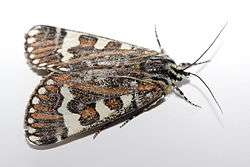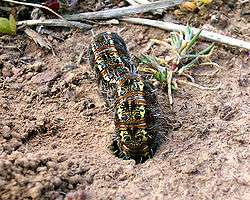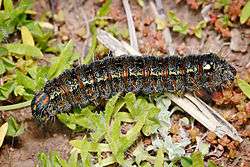Pasture day moth
The pasture day moth, Apina callisto (synonym Amazelo callisto), is a species in the moth family Noctuidae which is, as its name implies, active during the day, making it unlike most other noctuid species. It is found in most southern areas of Australia, ranging from lower Queensland to Tasmania.
| Pasture day moth | |
|---|---|
 | |
| Pasture day moth | |
| Scientific classification | |
| Kingdom: | |
| Phylum: | |
| Class: | |
| Order: | |
| Family: | |
| Genus: | |
| Species: | A. callisto |
| Binomial name | |
| Apina callisto Angas, 1847 | |
The pasture day moth lays its eggs in pastures, and they hatch after heavy rains in early spring. When the larvae are fully grown, measuring about 60 mm (2.4 in), they burrow down before becoming pupae. They have striking coloration; two yellow stripes run down their mottled-black back, interspersed with blue spots. Their bodies are covered with white spines. They feed on various broad leaved plants (see list below).
The adult moth's wings are black with cream and chestnut markings, with a wingspan of approximately 50 mm (2.0 in). Its thorax is black and the abdomen is orange ringed with black.

Recorded food plants

- Arctotheca - capeweed
- Erodium - storksbill
- Lepidium
- Malva - mallow
- [Modiola]] - bristle mallow
- Plantago - plantain
- Poaceae - grasses (including Paspalum)
- Rumex
- Salvia - sage
- Sonchus - sow-thistle
- Trifolium - clover
| Wikimedia Commons has media related to Apina callisto. |